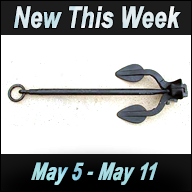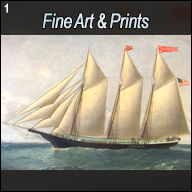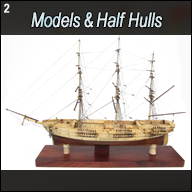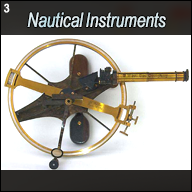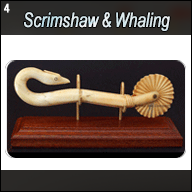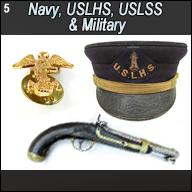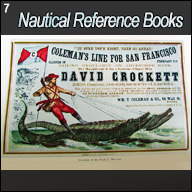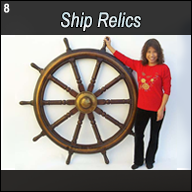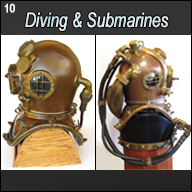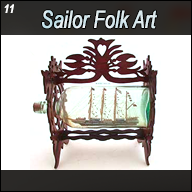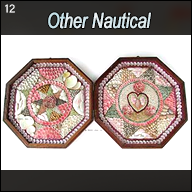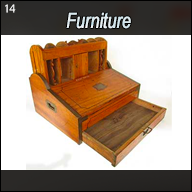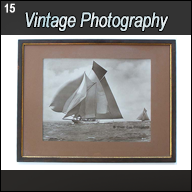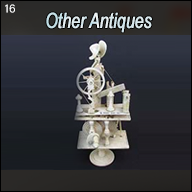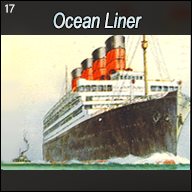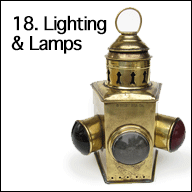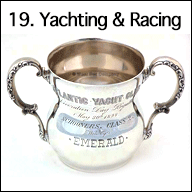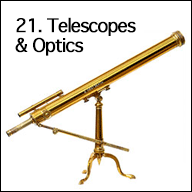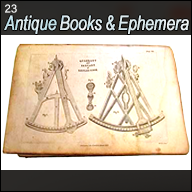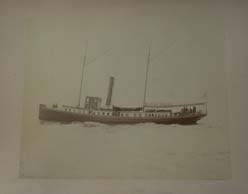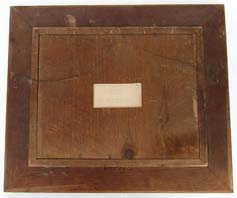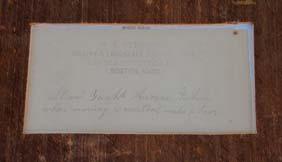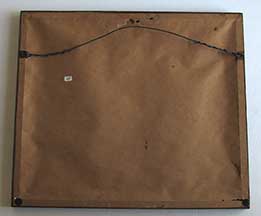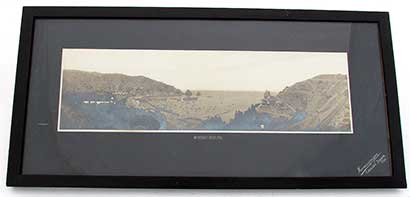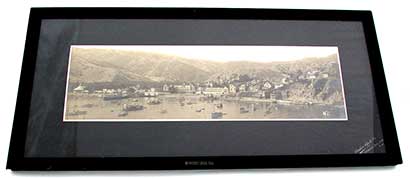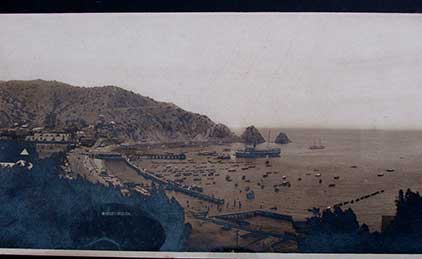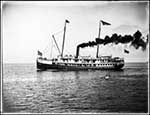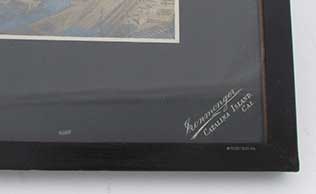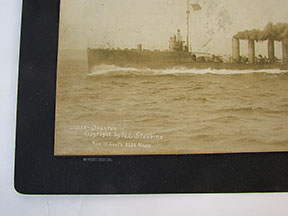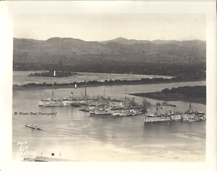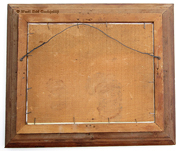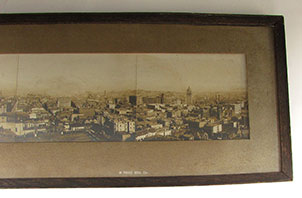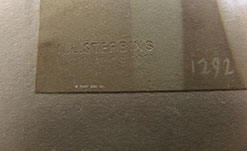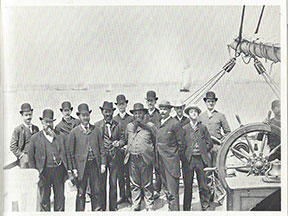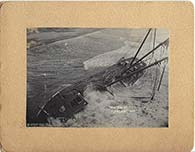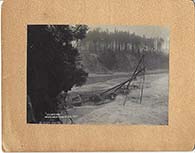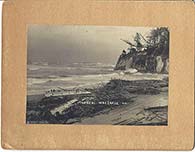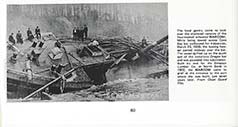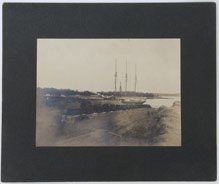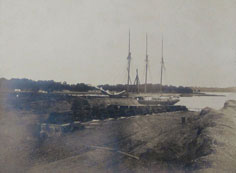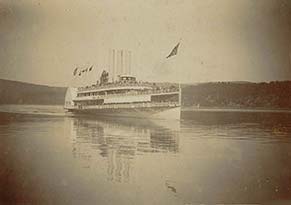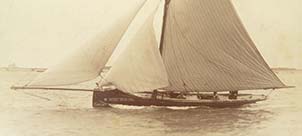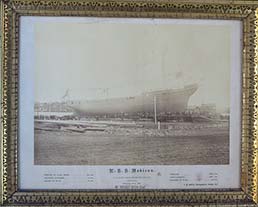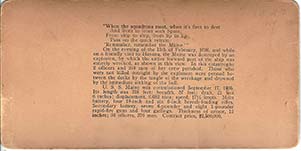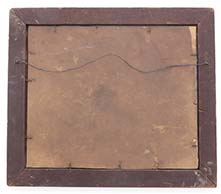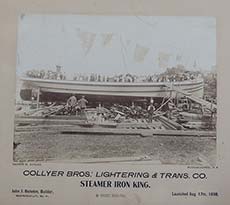15. Early Photography
Prices in U.S. Dollars are in GREEN
 |
15.45 LAUNCHING PHOTO. Original 19th century photograph of a 2-masted schooner on the ways ready to launch. This authentic albumen image depicts the ship with its beautifully-carved billet head and ornate trailboard reading “LSL P. HODGKINS BUILDER.” The curvaceous white hull has a very prominent bowsprit which overhangs the access ramp and scaffolding. The clear image is custom matted under glass in a modern wooden frame with gilt liner. The image measures 4 ¼ by 7 inches sight, and the frame is 10 ¼ by 13 ¼ inches. Excellent condition. Bargain priced. WAS $295 NOW! 49 It was quite unusual for builder’s name to be so prominently displayed on the vessel. The Hodgkins Company operated out of Gardiner, Maine in the second half of the 19th century. |
 |
 |
| detail | back |
 |
15.44 FAMOUS SHIP PHOTO. Period black and white photo of the famous Arctic research ship and former whaler, the USS BEAR at dock in Oakland, California circa 1935. An interesting original type written history of the venerable ship up to that time is attached to the back. 19 BEAR was one of very few U.S. Navy ships to have participated in the Spanish-American War, the First World War and the Second World War! In the World War II she actively served as a commissioned ship in the U.S. Navy. Decommissioned after the War she was acquired by private interests in Canada. In 1962 her owner intended to convert her into a floating seafood restaurant. But those plans were dashed when the 91 year old ship foundered and sank in a gale 260 miles off the coast of Boston. |
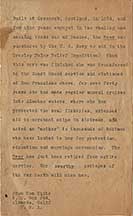 |
| back |
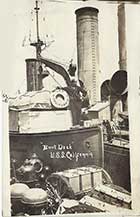
|
5.23/15.42 PHOTOGRAPH U.S.S. CALIFORNIA. Historic original photograph entitled "Boat Deck U.S.S. California" showing a sailor posed on a crane next to a lifering marked USS 2 2 CALIFORNIA. Below are 2 early binnacles and 2 pelorus stands along with two wheeled ammunition limbers. The ship appears to be nested next to another capital warship with towering smokestack, huge funnels and a sailor leaning on the rail. 3 ½ by 5 ½ inches. This is an interesting identified professional photograph with very unusual subject matter. Pre-1910. 59 |

|
15.36 ARTISTIC PHOTOGRAPH. Turn-of -the 1900's artistic black and white photograph of a 2-masted fishing schooner alongside a boathouse in an early new England setting with boats and town in the background, most likely Cape Cod. This very clear early silver print measures 5 ¾ by 8 inches and is housed in its original custom mat measuring 11 by 14 inches. Perfect original condition. Ideal for framing. Was $299 NOW! 95 |
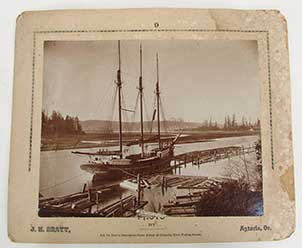
|
15.38 ARTIST SIGNED SHIP PHOTOGRAPH. Late 1800's albumen photograph of a lumber ship on the Columbia River near Astoria, Oregon. This professional photograph is marked "PHOTO By J.H. BRATT, Astoria Ore." It depicts a fine 3-masted schooner in a quarter stern view amongst log rafts in the slough adjacent to the mighty river. The name of the vessel is the "LAURA MADSEN, SAN FRANCISCO" as is clearly legible on the stern. It is a nice panoramic image with great detail especially of the ship. The image measures 71/2 by 9 ¼ inches. It is mounted on its original card 10 by 12 inches. The image itself is in perfect original condition. The card has some spotting on the right end. But it would be all but unnoticeable if properly matted and framed. A rare, signed and identified image of the famous Northwest lumber trade. Was $349 NOW! 129 |

|
15.41 PHOTOGRAPH. Late 19th century silver process photograph identified as the "Bark Levi G. Burgess J. Younger, Master" as hand written across the bottom. This period image shows the Burgess alongside the wharf. An old fashioned steam "donkey engine" can be seen to the left, and in the background the roof of one of the buildings reads "...RSON BUILDER." This image shows good detail under magnification and the vessel name can clearly be seen on the port bow. The image measures 7 by 9 inches sight and is in perfect condition. It is mounted on it original card (rough edges) with the additional notation on the back, "Built Thomaston (Maine) 1877." A really handsome antique photograph of a famous American windjammer, perfect for framing. WAS $329 NOW! 169 |

|
15.92 FAMOUS PHOTOGRAPH. Original late 19th century, large format albumen photograph signed and identified by the noted Boston marine photographer Nathaniel L. Stebbins. This handsome example is "blind signed" (impressed) lower right "N.L. STEBBINS Photo BOSTON." Then it is stamped in ink on the reverse, "N. L. STEBBINS. MARINE & LANDSCAPE PHOTOGRAPHER, 521 WASHINGTON ST. BOSTON, MASS." Further it is pencil signed in the photographer's own cursive hand, "Steam Yacht Aurora taken when moving 10 nautical miles per hour." This photo depicts the large 2-masted steam/sail yacht on the port beam. The detail of this photograph bears close scrutiny under magnification showing 2 crewmen on the foc'scle, the vessel's nameboard reading "AURORA" on the pilothouse, looming smokestack and at least 6 of the owner's party on the fantail. The image measures 9 3/8 by 7 ¾ inches sight and is matted on its original tan mat under the original old wavy glass measuring 13 ½ by 10 ½ inches. It is housed in the original solid oak frame with fancy gilt liner measuring 20 by 17 inches overall. The back retains its original single pine board backing held in with hand-cut square nails. The overall presentation is in excellent original condition throughout. WAS $395 NOW! 195 |
detail |
back |
label |
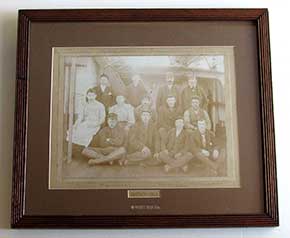
|
15.34 CREW PHOTO. Late 19th century ship's crew photo depicting the ship's company of the 4-masted British barque GUNFORD in port San Francisco. This sepia tone albumen photograph shows the 13 sailors on the wooden deck forward of the midship house. The only member of the crew with a beard is the Captain in jacket and tie right rear. On the left rear of that row is the Mate with button jacket and white dress shirt. "Cookie" is seated just in front of him. On the right end of that row is the only black crew member who appears to have equal status among the otherwise all white crew. The bottom left of the photo is fancily impressed in script "J. H. Wilton Marine Photo. " The bottom right is signed "With the Elite 838 Market St. S.F." This photo is clear and bright with no damage. It is conservation mounted with a brown mat under glass in a period wood frame measures 13 by 15 ¼. The image itself is 7 ½ by 9 ½ inches. Excellent original condition throughout. WAS $395 NOW! 195 |
detail |
back |
A |
B |
15.35 CATALINA ISLAND PHOTOS. Particularly fine matched pair of professional photographs showing Avalon Harbor in its very earliest days. These two photos, circa 1905, depict rare panoramic views of the harbor, one looking to the west and the other to the north. These classic silver plate images are of very high resolution and bear close scrutiny under magnification to reveal surprising details. Both images are beautifully framed and matted in their original simple black wooden frames under old way glass. The back of one bears the label of "Younker Brothers Picture and Gift Shop, Des Moines." Both are signed in the photographer's own lovely cursive script "Gronmonger CATALINA ISLAND, CAL." lower right . These exceptional photographs depict the sleepy island town years before it became a Mecca for tourists. In the harbor are small steamboats, most notably the famous excursion vessel the S.S. HERMOSA surrounded by numerous private sailing craft. Two side wheel steamers are festooned with decorative flags and pennants suggesting these photos might have been taken on an important day. On the waterfront the "Grand View Hotel" is visible as is "William Judd's General Merchandise" store. Also visible are "HUNTS' and "PACIFIC" signs, "Hotel Windsor" and "Billiards." The Steamship Pier (built 1887) is clearly visible in both images with the S.S. HERMOSA alongside. Several tourists can be seen along the promenade, most notably high fashion women with their bustle dresses and huge Edwardian hats. On the right of the waterfront image can be seen an amazing wooden staircase with eight flights! These crisp, revealing photos, over 110 years old, depict a forgotten era long before the current hustle and bustle of modern America – particularly frenetic Los Angeles only a few miles away! As testament to the dating of these photos, the original S.S. HERMOSA, shown here, was replaced by HERMOSA II in 1906. A very similar image shows the HERMOSA I in the harbor, dated 1903. 595/pair |
A - detail |
A - image |
b - detail |
b - image |
s.S. hERMOSA |
label |
signature |

|
5.70 / 15.33 FAMOUS ORIGINAL PHOTO. Genuine silver plate photograph of one of the very first “4-piper” destroyers, USS DRAYTON, conducting speed trails. DRAYTON was laid down on August 19, 1909 at the Bath Iron Works Bath, Maine. She was launched on August 22, 1910 and commissioned on October 29th. This photo is signed lower left “USS Drayton Copyright by N. L. Stebbins, Run 25 South 32.88 Knots.” Although undated it is obviously 1910 before commissioning. The sepia tone image clearly shows the sleek vessel belching coal smoke in a mighty effort to attain top speed. Scrutiny under magnification shows crewmen on the bridge and just aft on deck. It is interesting to note this photograph was taken prior to the installation of the ship’s armament. Measuring 7 ½ by 9 ¼ inches sight, it is mounted on the stiff card 9 ½ by 11 ¼ inches. There are a few light stains here and there, but in general the image is clear without faults. A good original photograph by one of New England’s premier marine photographers over 110 years old! 99 |
detail |
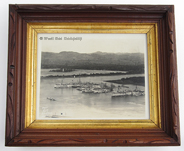
|
15.78 EARLY SUBMARINES PHOTO. Important, historic bird’s eye view photograph of the United State Navy's fledgling submarine base at the Panama Canal just after the First World War. This documentary sepia tone photograph on heavy card photographic paper depicts four large submarine tenders with submarines nested alongside. At least 13 submarines are seen in their berths with yet another clearly visible underway lower left. It is a high resolution image which bears close scrutiny under magnification, revealing details of the ships, the subs, a lighthouse in the distance and the masts and funnel of a ship at dock in the foreground. It is signed "PHOTO © BY A. E. WELLS" lower left. This original print measures 7 by 9 inches sight and 8 by 10 inches overall, housed in its original gilt walnut frame measuring 12 by 14 inches. Outstanding original condition. Clear and bright. A rare, historically important image documenting America's submarine service during its infancy! 295 This exact photograph is shown at: http://www.tendertale.com/ttd/ttd4/ttd4.html the U.S. Navy’s unofficial website for submarine tenders. It is entitled, “Photo # NH 42573 Submarines and submarine tenders at Cristobal Canal Zone, circa 1923.” The tenders are (left to right): SAVANNAH (AS-8), BUSHNELL (AS-2), BEAVER (AS-5) and CAMDEN (AS-6). Submarines are mostly "R" type boats, among them R-23 (SS-100) and R-25 (SS-102), both in the nest alongside SAVANNAH's port quarter. The bigger submarine alongside SAVANNAH's bow may be S-1 (SS-105), with her large seaplane hangar. As shown the vessels are moored in Manzanillo Bay just off of Coco Solo Point to the right. The lighthouse is on Margarita Island and the pier in the foreground is Manzanillo Point. When the Panama Canal opened in January of 1914 the United States was very concerned about protecting its strategic investment. At that time submarines were still considered as a coastal defense force and not useful for much else. So like Naval forces on Asiatic Station "showing the flag," five C Boats (OCTOPUS, STINGRAY, TARPON, BONITA, and SNAPPER) were deployed to Coco Solo with their tenders. A. E. Wells was THE official photographer for the U.S. Navy, War Department in the early 1920's. His photographs are contained in the archives of the Naval History and Heritage Command, Washington D.C. as well as numerous American museums nation wide. |
image |
back |

|
15.31 LAUNCHING PHOTO. Important late 19th century albumen photograph of the launch of the American gunboat USS NASHVILLE by the Newport News Shipbuilding and Drydock Company in 1895. This handsome, very clear albumen photograph is mounted on its original stiff card signed “HART, Photo 139 Sands St., Brooklyn.” The photo itself is signed in the photographer’s own hand “Hart “There She goes” (Nashville.)” Below the image the card is boldly printed with the inscription “Double Launch, Newport News, October 19th, 1895, U.S. Gunboats “NASHVILLE” and “WWILMINGTON.” NEWPORT NEWS SHIPBUILDING AND DRYDOCK COMPANY.” The perfect image measures 9 by 7 inches sight and the large mounted card is 14 ¾ by 12 ¼ inches. An accompanying early photocopy (literally) of a letter to the original owner from the Library of Congress is dated 1957 which indicates this important image is lacking in that prestigious collection. The condition of this original photograph over 120 years old is absolutely as good as it gets! 289 |
detail |
launch |
letter |

|
left signature |
center |
right |
back |

|
15.28 FAMOUS IDENTIFIED PHOTOGRAPH. Genuine 4th quarter 19th century albumen photograph taken in Boston Harbor by the famous marine photographer Nathaniel Stebbins as blind signed (impressed) lower left “N.L. STEBBINS PHOTO, BOSTON” and numbered “1292.” It depicts some of Boston’s maritime gentry standing on the poop deck of a sailing ship with the aft boom, ship’s helm, helmsman and helm bell clearly visible. In the distance is the faint outline of Boston harbor with a variety of watercraft. This very image is pictured and described on pages 346 and 347 in the section “Deep Water Sail,” of W. H. Bunting’s fine photographic record book, “Portrait of a Port, Boston, 1852-1914,” 1971, Harvard College. The full page caption reads (in part), “June 6, 1887, “The ship Panay, of Salem, tows down the harbor. She is bound for Manila with 33,000 cases of oil, and will return in eleven months with 1437.5 tons of sugar. This will be her eighth voyage to the Far East. The departure of a sailing vessel for a long voyage was often a social occasion, and a group of well wishers and relatives usually towed down the harbor on the vessel, to return with the tug. Several of the personages in the front row are identifiable…” This image measures 7 ½ by 9 1.2 inches sight and is mounted on its original hard photographic card under old wavy glass in its original ornate gilt frame measuring 13 by 16 inches. Outstanding original condition. 485 |
detail |
back |
signature |
plate |
caption |

|
15.21 FAMOUS RIVERBOAT PHOTOGRAPH. Original, commercially-produced photographic representation of the famed stern wheel river boat GEORGE C. GREENE. It depicts a port broadside view of the grand vessel underway belching black coal smoke as it passes the river bank in the background. Below the main image are the identified portraits of Tom R. Green, Master, and Captain Mary R. Greene. Signed by their own hand in period ink are the signatures of Tom R. Green, and Mary B. Greene, among others. The actual image of the steamboat measures 5 ¼ by 9 ¼ inches with the entire presentation being 8 by 9 ½ inches. Perfect original condition, mounted under shrink wrap on a foam core backing. The GREEN was converted to oil in 1936. This image clearly depicts the boat prior to that conversion. 95 The stern paddle wheeler was built by the Howard Ship Yards & Dock Company at Jeffersonville, Indiana, for the Eagle Packet Company and launched in 1923. She was christened CAPE GIRADEAU on April 24, 1924. She had a length of 201 feet, a beam of 38 feet. A true, traditional stern wheel riverboat, she was initially employed in the packet trade carrying passengers and freight between Louisville, Kentucky and St. Louis, Missouri, along with annual trips to New Orleans for Mardi Gras. |
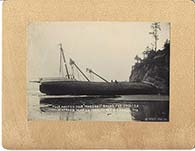
|
15.20 RARE PHOTO GROUPING. Matched set of 5 original silverplate black and white photographs of the famous 4-masted lumber schooner MARCONI wrecked on the Oregon Coast. The first shows a close-up of the starboard hull hard aground on the beach. It is captioned in the photographer’s own hand “FOUR MASTED SCHR. “MARCONI” BOUND FOR CHILI, S.A. WRECKED MAR 23, 1903. NEAR CAPE ARAGO. 243.” The second is an aerial view of the wrecked vessel awash in the surf entitled “WRECK OF THE “MARCONI.” 237- “ The third, broader view with the beach and the tree line in the background reads, “MARCONI” WRECKED MAR 23.09. 236.” The fourth shows the ill-fated ship on the beach listing to port with her masts in tatters, the inscription in the photographer’s hand reads, “”MARCONI” ON THE BEACH – 240.” The fifth images shows the doomed ship as no more than a pile of timbers and wreckage on the beach with Point Arago in the background. It reads “MARCONI WRECKAGE. -235-“ All images measure 4 5/8 by 6 ½ inches and are in perfect condition. They are mounted on their original stiff cards measuring 7 by 9 inches. These are also very good, noting two have slightly dog-eared lower left corners. An original photo set over 105 years old! 395/all The famous wreck of the MARCONI is recorded in several well known books on the topic. Among them, Jim Gibb’s “West Coast Windjammers,” 1968, Superior Publishing Co., Seattle, where the wreck is depicted on 3 different pages. On page 49 the caption reads, “Battered remnants of the four-masted schooner “Marconi” on the beach below Coos Head after her towline parted on Coos Bay bar March 23, 1909. The crew was rescued but the lumber laden windship was totaled out." Then in another Gibbs book, “Disaster Log of Ships,” 1971, Superior Publishing, the wreck is depicted on page 60 with the caption, “The local gentry come to look over the shattered remains of the four-masted schooner MARCONI. While being towed across Coos Bay bar outbound for Valpariso, March 23, 1909, the towing hawser parted midway over the bar. The vessel drifted up on the south spit of the notorious Oregon bar and was pounded into submission. Built by and for the Simpson Lumber Co. at North Bend in 1902, the MARCONI came to grief at the entrance to the port where she was built, just seven years later.” That photo is shown as "PLATE" below. |
two |
three |
four |
five |
plate |
15.88 SCARCE MID-WEST NAUTICAL PHOTO. Authentic 19th century albumen photograph of the 3-masted schooner C. C. MILLER in drydock. The upper left back of the photographed is penned in old ink “C.C. Miller,” then in pencil “Des Moines.” The clear original image was printed from a glass plate then mounted on its original heavy photo card mount measuring 10 by 12 inches. The image is 6 by 8 inches sight. Untouched original condition. 19 |

|
15.15 PERIOD NAVY PHOTO. Genuine sepia tone photograph of an old battleship taking a direct hit. It is titled lower center “SINKING THE U.S.S. EX-IOWA BY 14 IN. GUN FIRE.” It is signed and numbered “22 – March - 23© by A.E. WELLS 4774” lower left. The image is clear and bright, but there is some water spotting which actually may have been on the negative. 8 by 10 inches with a ½ inch border. 19 |

|
15.12 ROYAL YACHT PHOTOGRAPH. Authentic, identified real-time photo of Kaiser Wilhelm II’s Royal Yacht SMY HOHENZOLLERN II at her berth in New York City in 1902. This striking albumen photograph in rich sepia tones depicts the splendid yacht from a starboard bow perspective alongside a pier. The image is clear and precise eliciting many details when viewed under magnification. To the left of the vessel in the photograph can be seen the snow covered banks of the Hudson River with a 3-masted schooner at anchor. A sole crewman can also be seen on the flying bridge. This photograph was taken on February 25, 1902 when HOHENZOLLERN with Prince Heinrich embarked, visited President Theodore Roosevelt. Interestingly, just above the forecastle of the HOHENSOLLERN can be seen 3 massive funnels of a liner berthed on the opposite side of the pier. This original old image is well preserved, mounted on non-acidic foam core under shrink wrap and measures 7 ¼ by 9 ½ inches sight. Perfect original condition. An important original photograph with a number of significant ties to yachting, Royalty and the U.S. Presidency. Over 100 years old! 149 |
COLOR PLATE |
SHIP |
PRINCE & PRESIDENT |
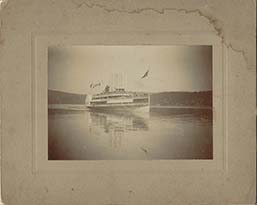
|
15.10 HUDSON RIVER PHOTOGRAPH. Latter half 1800's albumen photograph of the grand passenger stern wheeler NEW YORK steaming down the Hudson on a bright, sunny day absolutely crammed with passengers on all 3 decks. The huge river steamer plies the placid river, her reflection clearly showing in the water in the foreground. The ship flies the Union Jack from the jack staff and at least 4 other flags aft, including the American ensign. This early river boat has the unusual feature of 3 large smoke stacks positioned abreast of one another and forward of its old fashioned rocking beam engine. Two masts are in evidence, one just forward of the pilot house and the other aft. All the way astern can be seen the massive paddle box clearly marked “NEW YORK” on its side. The white hulled vessel appears to be beautifully maintained as the well dressed passengers regale its every inch of space. The thickly wooded banks of the Hudson River are clearly visible on both sides of the photograph. It measures 4 ½ by 6 3/8 inches sight and is mounted on its original stiff photograph card measuring 8 by 10 ¼ inches. The image is in excellent original condition and bears close scrutiny under magnification revealing many interesting details. The original card is complete and sound, but does have a water stain in the upper right quadrant. This could be easily matted out when the photograph is framed. Currently preserved under shrink wrap mounted on foam core. 149 |
IMAGE |
SHIP |

|
15.09 IDENTIFIED PHOTO. Extra nice authentic 19th century cabinet card photograph of a racing cutter under full sail at sea. This antique albumen photograph clearly depicts the classic yacht with long bowsprit, two head sails, gaff and billowing mainsail on a port tack. It flies a yacht pennant from the mast. Two crewmen can clearly be seen in their respective positions on deck. In the background lies a long narrow sandy shore with 3 ramps leading to the water with two large vessels shown. This handsome old photograph is blind signed (impressed) “West & Son Copyright, Southsea & Gosport ” lower right. Then on the back, upper left the vessel is identified in pencil as the “Currytush.”The image measures 5 ¾ by 8 ½ inches sight and is mounted on its original heavy photographic card measuring 6 ½ by 8 ½ inches. A fine original example of professional quality marine photograph in near perfect original condition. 195 |
DETAIL |
SIGNATURE |

|
DETAIL |
SUPER DETAIL |
IMAGE |
BACK |
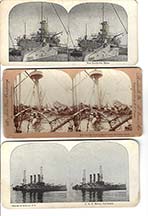
|
15.03 HISTORIC STEREO CARDS. Group of 3 original historically important stereo cards relating to the famous Battleship MAINE of Spanish-American War fame. The oldest card, circa 1895, depicts the “New Battleship Maine,” as entitled lower right, on a port bow perspective. The second graphically documents the horrific damage incurred by the ship on February 15, 1898. It is entitled “General View of the Wrecked Battleship Maine” and is signed in cursive script on the ends, “Keystone View Company, Meadville, Pa; St. Louis, Mo., Copyright 1898 by B.L. Lingley.” An extensive write-up of the ship’s characteristics and its demise is printed on the reverse. The third card depicts the second Battleship Maine which was authorized soon after its namesake was sunk. This truly “new” battleship Maine was launched ship and commissioned on. The view depicts the stately ship with 3 funnels and 2 cage mast seen from the starboard side and is signed along the bottom “Copyright E. Muller Jr., N. Y. / U.S.S. Maine, battleship.” All three cards are in excellent original condition, measuring the standard 3 ¾ by 7 ¼ inches each. 59 |
back |
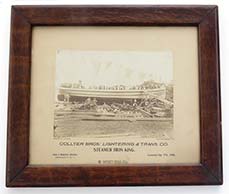
|
15.02 19th CENTURY SHIP LAUNCHING PHOTO. Genuine albumen photograph taken at the gala launching of the ship identified as the “Steamer Iron King.” The wooden hulled vessel is shown on the ways with scores of well wishers on deck. Above them numerous flags and pennants fly, including the ship’s name pennant discernable as “IRON KING.” In The foreground several shipyard workers stand amidst dunnage and timbers. Two gentlemen dressed in suits, their backs to the camera, possibly the owners, take in the scene. The very clear image bears scrutiny under magnification to reveal numerous interesting details. It measures 6 1/8 by 8 ¼ inches sight. It is signed by the photographer “George W. Burger” lower left, of “Poughkeepsie, N.Y.” lower right. It is boldly entitled “COLLYER BROS.’ LIGHTERING & TRANS. CO. STEAMER IRON KING. John J. Baisden, Builder, Rondout, N.Y. Launched Aug. 17th, 1898.” This authentic photograph is housed under old wavy glass in its original simple oak frame measuring 12 ¾ by 14 ¾ inches. Untouched original condition. 295 |
BACK |
DETAIL |

